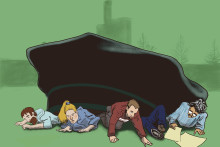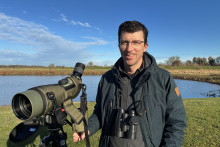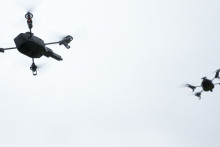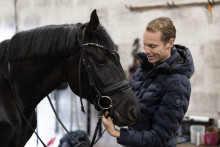How have these first five years been for the Fraunhofer Project Center?
Gibson: ‘I arrived in the summer of 2018, when the center had been up and running for about one and a half years. It was still a relatively small team back then, with four engineers and some fulltime staff members involved. A few projects running and a few interactions with the Fraunhofer Institute for Production Technology in Aachen. That’s the way it looked, still in a relatively early stage. I guess we’ve grown quite dramatically since then. And we went through some organisational changes as well. We started with people with a reasonable amount of industry experience and then switched to people with a more academic background. We now have a good blend of people, which fits very well in how we try to fit in the overall framework.’
Was that the challenge these past years, fitting in?
Gibson: ‘In a way, yes. When you’ve just started, it comes down to identifying yourself and finding your place between all these different entities. Not only with regards to the industry, but also within the UT and the rest of Fraunhofer. But I think we’ve arrived at that point where we – and others – know where we stand in the entire framework. We’ve found our footing.’
Herben: ‘Indeed, this exploratory expedition took some time. And we also started out from a very broad perspective: what were the needs of the industry, especially the regional industry with a lot of small and medium-sized companies? And what are the relevant topics that connect the questions from the industry with the expertise from the UT and Fraunhofer? We quickly noticed that our work was not only about developing solutions, but also about helping industry partners in defining their needs. In that sense, we’re a good enabler. We try to be a linking pin between the industry and strategic partners like Fraunhofer and the UT.’

Scientific director Ian Gibson. Also read: 'Fraunhofer has to be successful'.
Were you able to find your way to people within the UT, with its own hierarchy and (unwritten) rules?
Herben: ‘Quite well, actually. Over time, a lot of UT researchers have been involved, with the extent of their contributions depending on the topics from the industry partners. Some collaborations were more on a project basis, while others were more durable, with a couple of more involved researchers even being part of our scientific board. All in all, we found a lot of doors to knock on and we always found people very eager to help and collaborate. Also beyond the ET faculty, even though we’re very much connected, and residing on the third floor of the Horst tower. For examples, we have found collaborations with the S&T faculty, with researchers working in the field of materials science. Our role can be compared to the three research institutes of the UT. The big difference being that we’re not linked to any disciplines. We’re driven by topics.’
Five years ago, you mentioned that the goal of the Fraunhofer Project Center is to bridge the gap between the innovative ideas that emerge from scientific research and fully-fledged industry solutions. Is that still the main focus?
Herben: ‘That’s what we’re working on in the majority of our projects. We bring together the question from an industry partner and expertise from within the UT and Fraunhofer, and work on possible feasible solutions. Of course, we can’t deliver turnkey solutions, but helping partners in developing and finding such solutions, that’s what we do.’
Gibson: ‘And oftentimes, if you look at things from an industry perspective, companies usually see trends, but they are unsure about these trends fitting in with their needs and production environment. What we do is not just about high tech products, it’s also about the implementation and bringing expertise to the table.’
Do you have any concrete examples of that?
Gibson: ‘If you look at how covid has impacted supply chains, it shows that we have to be more adaptable. The automotive industry has come to an almost complete standstill, because of the shortage of chips for their vehicles. Which is ironic since the many of the companies that supply the machines that create these chips, like ASML, come from the region. It shows that even on a regional level, like in Twente, you have to look at things from both a local and global perspective. So you can respond to and buffer yourself against these major developments.’
Herben: ‘On a more concrete, project level, we helped out the local aerospace company Aeronamic, to name just one example. They wanted to implement additive manufacturing (also known as 3D printing, ed.) into their production environment, so we helped them along in that process with our expertise. What we also noticed these past years, was a difference between a start-up and an established company like Aeronamic, with an already functioning production environment that is mostly looking for optimization. What we’ve seen quite a lot at start-ups, is that they developed a good product, but it’s not fit for a production environment – yet. So we can help in a design for manufacturing approach; to redefine a product so it’s fit to produce in a much larger scale. Specifically in the Twente region, with a lot of smaller-sized companies, this can be of added value.’

Program director Maurice Herben, at the opening of FPC in 2017.
One of the founding fathers of the Fraunhofer Project Center, Fred van Houten, passed away in 2020. How big of a loss was that?
Herben: ‘A tremendous and tremendously sad loss. In his formal position as scientific director, when the center just started, he was instrumental with his contacts with the local industry. Even when we had a more informal position as an advisor later on, he kept on being important. Naturally, we will make sure his legacy will live on in the future of our center.’
Looking ahead, what will the next years bring for the Fraunhofer Project Center?
Gibson: ‘After a lot of delays, the move to Kennispark should take place at the end of this year, or the beginning of 2023. We’re really excited about that. Not only because we’re spilling out of our space on the third floor of the Horst tower, but also because it offers more opportunities that we can’t do on other sites. Not only will we be more visible to the outside world, we will also have an own shop floor to demonstrate solutions to industry partners. It’s for a reason we refer to this new location as a magnet.’
Herben: ‘The location is also symbolic for our role: at the intersection, right across the main entrance of the UT. It shows that we are an integral part of the UT – which we will always will be, while also making the connection with the industry.’
Besides the move, what else is planned?
Gibson: ‘In the next few years, we focus on establishing a living shopfloor demonstrator; a fully connected, open-access manufacturing test bed, helping companies determine the impact of changes to their manufacturing processes. With this shopfloor, we provide cutting edge technologies and potential real-time solutions.’
Herben: ‘We are also looking at ways to integrate students into our organisation more, to also enable them to develop themselves in these kinds of industrial projects. We also think we’ll be able to grow towards a range of about forty staff members. However, it is not just about growth. It is about ensuring strength in the partnerships we make and the value we create.’







